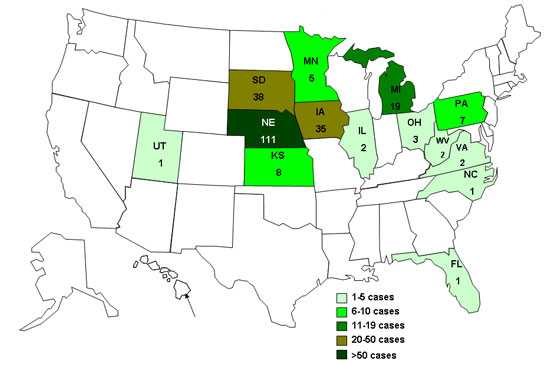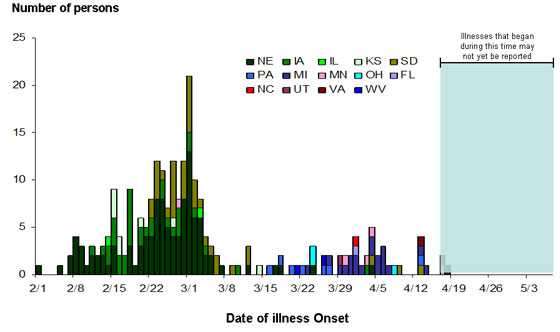Multistate Outbreak of Salmonella Saintpaul Infections Linked to Raw Alfalfa Sprouts (FINAL UPDATE)
NOTICE: This outbreak is over. The information on this page has been archived for historical purposes only and will not be updated.
Posted May 8, 2009
Outbreak Summary
As of May 7, 2009, 235 persons infected with the outbreak strain of Salmonella Saintpaul have been reported from 14 states. The number of ill persons identified in each state is as follows: Nebraska (111), Iowa (35), South Dakota (38), Michigan (19), Kansas (8), Pennsylvania (7), Minnesota (5), Ohio (3), Illinois (2), Virginia (2), West Virginia (2), Florida (1), North Carolina (1), and Utah (1).
Among the 234 persons with known illness onset dates, illnesses began between February 1 and April 15, 2009. Patients range in age from < 1 to 85 years; 68% are female. Among persons with available information, 3% reported being hospitalized. No deaths have been reported.
The outbreak can be visually described with a chart showing the number of persons who became ill each day. This chart is called an epidemic curve or epi curve. It shows that illnesses began in early February, peaked in early March and have been tapering off in April. Illnesses that occurred after April 17, 2009 may not yet be reported due to the time it takes between when a person becomes ill and when the illness is reported. This takes an average of 2 to 3 weeks. Please see the Timeline for Reporting Cases of Salmonella Infection for more details.
Outbreak Investigation
In February 2009, the Nebraska Department of Health and Human Services identified a higher than expected number of isolates of Salmonella serotype Saintpaul from sick persons which triggered an epidemiologic investigation by state and local public health officials. The investigation included case-patient interviews, a case-control study, laboratory testing of Salmonella strains by pulsed-field gel electrophoresis (PFGE), inspection of sprouting facilities, and environmental investigations of restaurants. A confirmed case was defined as illness in a person whose stool culture on or after February 1, 2009 yielded Salmonella Saintpaul with the outbreak strain PFGE patterns (XbaI JN6X01.0072, JN6X01.0252, JN6X01.0340, JN6X01.0709, JN6X01.0712, JN6X01.0718, JN6X01.0719). A probable case was illness in a person whose stool culture yielded Salmonella Saintpaul with a pending PFGE pattern. During January 1, 2008 to January 31, 2009, only four cases of the outbreak strain of Salmonella Saintpaul were identified by PulseNet (the national molecular subtyping network for foodborne disease surveillance).
On February 26, 2009 a notice about a cluster of case-patients with Salmonella Saintpaul infection among residents of Nebraska was distributed to US State public health officials. Additional cases were then reported from health departments in Iowa, South Dakota, Minnesota, Kansas and Missouri. Interviews showed that five of 14 Nebraska case-patients patronized a common restaurant chain (Chain A) and that nine had recently consumed alfalfa sprouts. Interviews of the first seven Iowa case-patients identified Chain A exposure in one and alfalfa sprout exposure in six. Alfalfa sprouts was the most common food item reported by the case-patients.
To determine if a particular food item or restaurant was associated with this outbreak, health officials in Nebraska and Iowa conducted a case-control study. The study revealed that case-patients were significantly more likely to have eaten alfalfa sprouts than matched controls [27/32 vs. 5/32, crude odds ratio (OR) = 29.2 (95% confidence interval (CI) = 7.6-112.4)]. No other food item was significantly associated with illness. Case-patients were significantly more likely to have eaten at Chain A than controls [24/32 vs. 10/32, OR=6.6 (95 % CI = 1.96-22.93)], but this association was no longer statistically significant upon adjustment for exposure to alfalfa sprouts.
By March 19, 2009, a total of 186 cases had been identified in Nebraska, South Dakota, Iowa, Illinois, Kansas, and Minnesota Of the 156 case-patients with completed interviews, 114 (73%) reported alfalfa sprout consumption.
Interviews with employees of restaurants and stores reported by case-patients as the source of their sprout exposure indicated that although the sprouts had been distributed by a variety of companies, all originated at the same sprouting facility (Facility A) in Omaha, Nebraska. FDA was notified and began an investigation. Of the 114 case-patients with reported alfalfa sprout exposure, 112 (98%) could be linked to a restaurant or a retail outlet that had received alfalfa sprouts from Facility A. On March 3, 2009, Facility A agreed to conduct a voluntary recall. The recall proceeded through the distributor channels, who contacted the retail establishments where the sprouts had been distributed.
Alfalfa Sprout Production at Facility A
Facility A produces several types of sprouts, including alfalfa, clover, radish, broccoli, and onion. The seeds for the alfalfa sprouts were distributed by Seed Company B and were shipped from a depot in Washington State. Facility A soaks alfalfa seeds for 15 minutes in a 20,000 ppm chlorine solution derived from calcium hypochlorite. The seeds are then rinsed and placed in germination containers. After 48 hours, a sample of the irrigation water is cultured for Salmonella and E. coli O157. There were no positive test results during January or February of 2009. Upon obtaining a negative microbiologic culture result and after a 96-hour germination period, the sprouts are refrigerated and then distributed to locations within a 250-mile radius of Omaha, Nebraska.
Facility A receives new shipments of alfalfa seed approximately once a month. Preliminary assessment of shipment, production, and distribution dates suggests that the outbreak is correlated with the distribution of sprouts from a seed shipment that arrived at Facility A on January 13, 2009, and was last sprouted on February 13, 2009. While multiple lots of seed purchased only from Seed Company B were used for producing alfalfa sprouts during the period of the outbreak, all lots of seed were identified with the prefix “032,” indicating that they originated from the same seed grower (Grower C).
Linking Cases to Multiple Sprout Growers and a Single Seed Grower
On April 13, 2009, CDC was informed that Salmonella Saintpaul with the outbreak strain PFGE pattern was isolated from stool samples of two West Virginia residents during March, 2009. The isolates from these case-patients had a PFGE pattern indistinguishable from those of earlier cases. One of these case-patients reported consumption of sprouts at a restaurant that received sprouts grown at Facility D in Pittsburgh, Pennsylvania. On April 16, 2009, CDC was informed of six patients with the outbreak strain among Pennsylvania residents whose illnesses began during March 2009. Three reported consumption of alfalfa sprouts that were grown at Facility D. A preliminary review of records indicates that Facility D received lots of seed identified with the prefix “032” from Seed Company B.
By May 1, 2009, additional cases with illnesses beginning after March 15, 2009 had been identified in Michigan, Minnesota, Nebraska, Ohio, Florida, North Carolina, Iowa, and Utah. At least 20 of these case-patients reported recently eating sprouts. Alfalfa sprouts eaten by these case-patients have been traced back to growing facilities in Michigan (Facility E) and Minnesota (Facility F). A preliminary review of records indicates that Facility E and Facility F received lots of seed identified with prefix “032” from Seed Company B. Alfalfa sprout irrigation water collected on March 10, 2009 from a growing facility in Wisconsin (Facility G) grew Salmonella Saintpaul indistinguishable from the outbreak strain. A review of Facility G’s records indicates these sprouts were grown from a lot of seed identified with prefix “032” received from Seed Company B. No human illnesses have been linked to Facility G.
Since February 1, 2009, including the earlier cases linked to Facility A, 235 case-patients infected with the outbreak strain of Salmonella Saintpaul have been reported from 13 states. The number of ill persons identified in each state is as follows: Nebraska (111), South Dakota (38), Iowa (35), Michigan (19), Kansas (8), Pennsylvania (7), Minnesota (5), Ohio (3), Illinois (2), Virginia (2), West Virginia (2), Florida (1), North Carolina (1), and Utah (1).
Preliminary findings from FDA’s investigation indicate that the lots of seeds identified with the prefix “032” were sold by Seed Company B in many states and may account for a large proportion of the alfalfa seeds that were being used by sprout growers during the outbreak. For this reason and because cases of illness are spread across multiple states, on April 26, 2009, FDA and CDC recommended that consumers not eat raw alfalfa sprouts, including sprout blends containing alfalfa sprouts, until further notice. On May 1, 2009 FDA alerted sprout growers and retailers that Seed Company B was voluntarily withdrawing from the market all alfalfa seeds bearing six digit lot numbers that start with “032.”
Final Case Count Map
Persons infected with the outbreak strain of Salmonella Saintpaul, by state of residence, as of May 7, 2009 (n=235)

As of May 7, 2009, 235 persons infected with the outbreak strain of Salmonella Saintpaul have been reported from 14 states. The number of ill persons identified in each state is as follows: Nebraska (111), Iowa (35), South Dakota (38), Michigan (19), Kansas (8), Pennsylvania (7), Minnesota (5), Ohio (3), Illinois (2), Virginia (2), West Virginia (2), Florida (1), North Carolina (1), and Utah (1).
Final Epi Curve
Persons infected with the outbreak strain of Salmonella Saintpaul, by date of illness onset*

*n=234 for whom information was reported as of May 7, 2009. Some illness onset dates have been estimated from other reported information.
The outbreak can be visually described with a chart showing the number of persons who became ill each day. This chart is called an epidemic curve or epi curve. It shows that illnesses began in early February, peaked in early March and have been tapering off in April. Illnesses that occurred after April 17, 2009 may not yet be reported due to the time it takes between when a person becomes ill and when the illness is reported. This takes an average of 2 to 3 weeks.
Advice for Consumers
- Do not eat raw alfalfa sprouts, including sprout blends containing alfalfa sprouts, until further notice.
- For persons who continue to eat sprouts, cook them first following FDA’s advice.
- Persons who think they may have become ill from eating raw alfalfa sprouts are advised to consult their health care providers.
Advice for Young Children, the Elderly, & Those with Compromised Immune Systems
- Never eat raw alfalfa sprouts.
Resources for the Sprout Industry
- FDA has provided a several resource documents for Seed Suppliers, Distributors, and Sprouters on their website.
Clinical Features of Salmonella Infection
Most persons infected with Salmonella develop diarrhea, fever, and abdominal cramps 12–72 hours after infection. Infection is usually diagnosed by culture of a stool sample. The illness usually lasts 4 to 7 days. Although most people recover without treatment, severe infections may occur. Infants, elderly persons, and those with impaired immune systems are more likely than others to develop severe illness. When severe infection occurs, Salmonella may spread from the intestines to the bloodstream and then to other body sites and can cause death unless the person is treated promptly with antibiotics.
For More Information
- Page last reviewed: May 8, 2009
- Page last updated: May 8, 2009
- Content Source:


 ShareCompartir
ShareCompartir